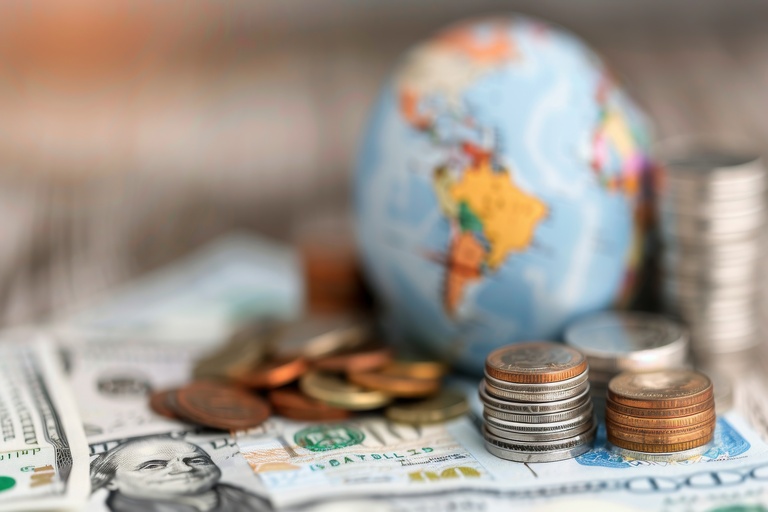
Global Exchange Rates: How Major Currencies From Countries Compare to the Indian Rupee
Table of contents
In today’s interconnected world, understanding how different currencies stack up against one another can help us better navigate international trade, travel, and investments.
Exchange rates are crucial indicators that reveal not just economic strength but also political stability and market demand. In this section, we’ll explore how ten of the world’s most prominent currencies compare to the Indian Rupee (INR), giving you a clearer picture of the currency landscape across countries.
Factors Influencing Exchange Rates and the Impact on the Indian Rupee

Exchange rates between currencies, such as the Indian Rupee and the ten global currencies mentioned earlier, are shaped by a multitude of factors that can shift over time. Understanding these influences can help make sense of why the currency rates of countries in Indian Rupees fluctuate and what it means for different aspects of the economy.
1. Economic Indicators and Policy Decisions
One of the primary drivers of exchange rates is the relative economic health of a country. Indicators like GDP growth, inflation, and unemployment rates provide a snapshot of a country’s economic performance. For India, positive growth indicators generally support the Rupee’s value against other currencies, as they signal economic stability. Conversely, periods of lower growth or rising inflation can put downward pressure on the Rupee, causing depreciation against stronger currencies like the US Dollar or the British Pound.
Monetary policy decisions made by central banks also play a critical role. In India, the Reserve Bank of India (RBI) regulates interest rates, impacting how attractive the Indian Rupee is to foreign investors. When the RBI raises interest rates, it often attracts more foreign investment, thereby strengthening the Rupee. This interaction helps shape the currency rates of countries in Indian Rupees.
2. Trade Balance and Import-Export Dynamics
The trade balance, which represents the difference between a country’s exports and imports, significantly affects exchange rates. India’s trade deficit, particularly due to heavy imports of crude oil, often results in a higher demand for foreign currencies like the US Dollar. This increased demand can weaken the Rupee. On the flip side, increased exports can strengthen the Rupee, as more foreign buyers convert their currencies to INR to pay for Indian goods.
China’s dominance as a key trading partner to India also has a significant effect on the Rupee. Since the Indian economy is largely reliant on imports from China, especially in electronics and machinery, fluctuations in the currency rates of countries in Indian Rupees, including the Chinese Yuan, directly influence India’s overall economic equilibrium.
3. Foreign Investments and Market Sentiment

The inflow and outflow of foreign investment are also vital determinants of currency rates. Foreign Institutional Investors (FIIs) and Foreign Direct Investments (FDIs) significantly impact the Indian Rupee’s value. When foreign investors show confidence in India, such as through investment in equities or infrastructure, demand for the Indian Rupee increases, leading to appreciation. Conversely, economic uncertainty or geopolitical tensions can lead to capital flight, with investors pulling money out of India, leading to a weaker Rupee.
For instance, the strength of the Swiss Franc against the Indian Rupee can be partly attributed to the Franc’s status as a safe-haven currency. During periods of global uncertainty, investors may prefer the Swiss Franc over emerging market currencies like the INR. This risk aversion often results in greater volatility in currency rates of countries in Indian Rupees, especially during times of global crises or economic downturns.
4. Global Commodity Prices
Global commodity prices, particularly oil, play a substantial role in determining the exchange rate of the Indian Rupee. Since India is one of the largest importers of crude oil, rising oil prices can put immense pressure on the Rupee by widening the trade deficit. This relationship illustrates why currency rates of countries in Indian Rupees can fluctuate rapidly when there are significant changes in global oil markets. Additionally, as resource-backed currencies like the Australian and Canadian Dollars shift with commodity prices, their exchange rate against the Indian Rupee often mirrors these global market changes.
A Comparative Overview of Major Global Currencies Against the Indian Rupee
The exchange rate of the Indian Rupee against global currencies offers insight into the dynamics between emerging and established economies. From the US Dollar to the UAE Dirham, each currency’s value relative to the Rupee highlights the factors that shape international trade and investment. Below, we explore ten significant global currencies and their current standing against the Indian Rupee.
1. US Dollar (USD) to Indian Rupee

The United States Dollar is one of the most traded currencies globally. As of recent data, 1 USD is equivalent to approximately 83.97 INR. The exchange rate between the US Dollar and the Indian Rupee is significantly influenced by factors like US Federal Reserve policies, economic activity, and investor confidence. India’s heavy reliance on imports, especially crude oil, also means that the value of the Indian Rupee tends to fluctuate in relation to the strength of the Dollar. The USD to INR exchange rate remains a key focus for investors, businesses, and travellers dealing in these two major economies.
2. Euro (EUR) to Indian Rupee

The Euro, the official currency of the Eurozone, is often considered one of the strongest currencies in the world. 1 Euro currently stands at about 92.07 INR. The Indian Rupee has had a history of depreciation against the Euro, given the differences in economic development between the Eurozone and India. This currency rate of countries in Indian Rupees showcases how the Indian currency fares against the combined economies of 20 European nations.
3. British Pound Sterling (GBP) to Indian Rupee

The British Pound Sterling is one of the oldest and most valuable currencies still in use. 1 GBP is roughly 110.09 INR. The British Pound has traditionally been stronger than the Indian Rupee due to the UK’s robust economic standing and historical economic stability. Post-Brexit changes have led to more fluctuations, but the Pound continues to maintain a significant edge over the Rupee. This currency rate of countries in Indian Rupees gives an idea of the differential power between a developed and an emerging market economy.
4. Australian Dollar (AUD) to Indian Rupee

The Australian Dollar is another major global currency. 1 AUD is valued at around 57.09 INR. Australia’s economic reliance on exports like iron ore and natural resources means that its currency rate against the Indian Rupee can be influenced by global commodity prices. For those travelling between India and Australia, monitoring these currency rates of countries in Indian Rupees can help plan the best times for transactions and exchanges.
5. Canadian Dollar (CAD) to Indian Rupee

The Canadian Dollar, like its Australian counterpart, is significantly influenced by commodities, particularly oil. 1 CAD is worth about 61.81 INR. The Indian Rupee has consistently remained weaker compared to the Canadian Dollar, partly due to India’s larger population and different economic dynamics. Exchange rate trends between the CAD and INR reflect the broader macroeconomic conditions in both countries, such as inflation rates and government policies.
6. Japanese Yen (JPY) to Indian Rupee

The Japanese Yen functions quite differently compared to Western currencies. Unlike the Dollar or Euro, 1 Japanese Yen equals approximately 0.57 INR, meaning 100 JPY equals about 55 to 60 INR. Japan’s low-interest rate policies have kept the value of the Yen relatively low, but due to this, the Indian Rupee generally holds an advantageous conversion rate. However, currency rate fluctuations between the Japanese Yen and the Indian Rupee are often linked to global investor confidence and Japan’s trade balance.
7. Swiss Franc (CHF) to Indian Rupee

The Swiss Franc is often referred to as a “safe-haven currency” due to Switzerland’s political neutrality and financial stability. 1 CHF is valued at roughly 97.86 INR. The Indian Rupee is much weaker than the Swiss Franc, a reflection of the economic and financial differences between India and Switzerland. The Swiss Franc’s appreciation can often signal broader risk aversion in global markets, which influences currency rates of countries in Indian Rupees in general.
8. Chinese Yuan (CNY) to Indian Rupee

The Chinese Yuan, representing the second-largest economy in the world, has a considerable influence in Asia. 1 CNY is approximately 11.97 INR. The exchange rate of the Chinese Yuan to the Indian Rupee shows the dynamic trade relationship between the two nations. China’s currency policies, which involve government control and intervention, often impact the exchange rate stability, and these shifts significantly influence trade balances with India.
9. Singapore Dollar (SGD) to Indian Rupee

Singapore, despite its size, has a thriving economy that reflects stability. 1 SGD is currently equivalent to around 64.36 INR. The Singapore Dollar is considerably stronger compared to the Indian Rupee, showcasing the economic prosperity of Singapore, which is largely driven by trade, finance, and high levels of productivity. This currency rate of countries in Indian Rupees highlights the difference between an advanced urban economy and an emerging market like India.
10. UAE Dirham (AED) to Indian Rupee

The United Arab Emirates Dirham holds a special place for many Indians because of the large number of expatriates residing in the Gulf. 1 AED is valued at approximately 22.86 INR. The UAE Dirham is pegged to the US Dollar, which means that its value relative to the Indian Rupee closely follows the Dollar’s movements. The Indian diaspora in the UAE also means that this currency rate of countries in Indian Rupees is an important consideration for remittances and economic connections between the two nations.
Key Takeaways on Global Currency Comparisons with the Indian Rupee
The comparison of these ten global currencies against the Indian Rupee reveals interesting insights into India’s economic standing in the international financial system. The currency rates of countries in Indian Rupees provide a view into the balance of trade, economic policies, and geopolitical influences at play.
- US Dollar, British Pound, Euro, and Swiss Franc are among the strongest currencies compared to the Indian Rupee. This reflects not only their established economic status but also the structural differences between a developed economy and an emerging one like India.
- The Japanese Yen and Chinese Yuan show India’s diverse economic relationships in Asia. The Yen offers a favourable rate for Indian consumers, while the Yuan’s movement shows the influence of China’s deliberate economic control.
- The Australian and Canadian Dollars reflect similarities in being resource-backed economies, and their value compared to the Indian Rupee indicates how natural resource markets can influence exchange rates.
- The UAE Dirham is notably relevant for millions of Indian workers in the Gulf, and the remittances play a vital role in India’s economy.
The currency rates of countries in Indian Rupees fluctuate continuously based on several factors, including inflation, interest rates, trade balances, and political events. For anyone engaging in international business, travel, or investment, keeping an eye on these rates is crucial.
Planning Your Financial Strategies
Whether it’s planning a vacation to Europe, exporting goods to the United States, or receiving remittances from the UAE, understanding how the Indian Rupee compares to global currencies can provide valuable context. It reflects not only the health of the Indian economy but also the intricate web of global economic relations in which India is enmeshed. Exchange rates, while often driven by complex financial forces, are an everyday concern for many individuals and businesses, impacting decisions big and small.
Navigating the currency rates of countries in Indian Rupees effectively can lead to better financial planning, more informed investment decisions, and smarter travel itineraries. While the Indian Rupee faces challenges, particularly when compared to major global currencies, its resilience is also evident in the face of ongoing economic development and increasing global integration.
Table of contents
Our Forex Offerings
Trending blogs for you
Recommended Articles for you
How to Take a Career Break and Travel the World
Reading Time: 4 minutes 0 0 Have you ever dreamt of taking a career break to travel the world but felt unsure about how to make it happen? The thought of stepping away from a stable job and embracing the unknown might seem daunting, […]
Travelling with an Indian Passport: Forex Tips and Currency Regulations
Reading Time: 5 minutes 0 0 Travelling abroad is an exciting experience, but managing foreign exchange efficiently is crucial to ensure a hassle-free trip. As an Indian passport holder, understanding currency regulations, forex options, and best practices can help you avoid unnecessary complications. Whether […]
Why Wellness Travel is the Next Big Trend You Should Try
Reading Time: 5 minutes 0 0 In today’s fast-paced world, where work stress, digital fatigue, and lifestyle-related health issues are on the rise, more people are looking for ways to relax and rejuvenate. This has led to the growing popularity of wellness travel—a trend […]
Traveling With a Japanese Visa: Ultimate Guide
Reading Time: 4 minutes 0 0 Planning a trip to Japan? Whether you’re visiting the bustling streets of Tokyo, the serene temples of Kyoto, or the breathtaking landscapes of Hokkaido, managing your finances wisely is key to a smooth and stress-free experience. Understanding the […]
Planning a Trip with a US Tourist Visa: Best Tips for Travelers
Reading Time: 4 minutes 0 0 Planning a trip to the United States is an exciting experience, whether you’re visiting New York’s bustling streets, exploring the stunning landscapes of the Grand Canyon, or enjoying the magic of Disneyland. However, managing your finances wisely is […]
15+ Places to Visit in Ooty – The Queen Of Hill Stations
Reading Time: 9 minutes 0 0 How does this sound to you: bright green soothing slopes, mystical pathways, and clouds that kiss your hair? Ooty is replete with such immense beauty and has enough activities and elements to keep every traveler happy and satisfied.One […]
PAR: Hong Kong Visa Myths Busted
Reading Time: 6 minutes 0 0 Hong Kong, the Special Administrative Region of the People’s Republic of China (PRC), is increasingly becoming one of the most sought-after international holiday destinations for Indian tourists. This has something to do with its vibrant culture, iconic skyline, […]
Choosing the Best Forex Card for Your Travel Needs
Reading Time: 9 minutes 0 0 Travelling abroad can be an exciting adventure, but managing your finances while on a trip can sometimes be challenging. When visiting different countries, paying in local currency is essential to avoid the pitfalls of unfavourable exchange rates and […]
Top Zero Markup Credit Cards for Forex Transactions in India in 2025
Reading Time: 9 minutes 0 0 Traveling internationally often comes with various expenses, and one of the most significant is currency conversion. Traditional methods, such as exchanging cash or using credit/debit cards, usually involve hidden charges, hefty conversion fees, and unfavourable exchange rates. Enter […]
Why You Should Consider Trading Forex: 12 Key Insights
Reading Time: 5 minutes 0 0 Foreign exchange trading, commonly known as forex trading, has grown to become one of the most popular forms of trading worldwide. With a daily trading volume exceeding $7 trillion, it represents the largest and most liquid financial market. […]
Key Differences Between Regular Bank Accounts and Overseas Bank Accounts
Reading Time: 5 minutes 0 0 In a globalized world where people frequently travel, migrate, or conduct business across borders, understanding the distinction between regular bank accounts and overseas bank accounts is crucial. While both serve the primary purpose of storing and managing money, […]
Doorstep Forex Delivery and more by Thomas Cook
Reading Time: 4 minutes 0 0 Foreign Exchange today is one of the basic requirements for not only business travellers but tourists as well and getting a Doorstep Forex Delivery when you are really running late is truly a blessing! This is where reputed […]
Top 50 Famous Beaches in Goa Including the Ones You Don’t Know
Reading Time: 9 minutes -117 -178 Although it is one of the smallest states in India, Goa offers an abundance of beautiful beaches. Our Goa tour packages will be perfect for a much-needed break from our hectic lives. So here’s a list of Goa beaches […]
Hotter Than Hot: Exploring India’s Hottest Destinations
Reading Time: 10 minutes 0 0 Exploring the hottest places in India reveals more than just extreme temperatures; it uncovers a rich tapestry of cultures, intriguing histories, and breathtaking landscapes. From the arid deserts of Rajasthan to the blazing plains of Uttar Pradesh, each […]
10 Best Places To Visit In July In India On A Budget
Reading Time: 11 minutes 0 0 July, with its refreshing monsoon showers, transforms India into a vibrant tapestry of lush greenery and spectacular landscapes. For those who wish to explore the beauty of this transformation without causing a dent in their wallets, there are […]
Top 10 Coldest Places In India You Must Visit This Winter
Reading Time: 8 minutes 0 0 As winter approaches, the quest for crisp air and snow-covered landscapes draws many away from India’s typically mild winters. Embrace the season by venturing into the country’s coldest regions, where each destination offers a unique blend of natural […]
12 Best Places To Visit In November In India In 2025
Reading Time: 8 minutes 0 0 November is a month of vibrant transitions in India, offering an array of travel experiences from the cool Himalayan foothills to the warm beaches of the south. If you’re planning your travel itinerary for November 2024, India presents […]
10 Stunning Places To Visit In October In India To Experience the Autumn
Reading Time: 11 minutes 0 0 10 Stunning Places To Visit In October In India To Experience the Autumn October marks a magical time in India when the monsoon rains have ceased, and the landscape bursts with vibrant colours, making it an outstanding month […]
September Travel Guide – 8 Offbeat Places to Visit in September in India
Reading Time: 4 minutes 0 0 As the monsoon starts to wane, September brings forth the vibrant palette of India with its pleasant climate and colourful festivals, making it an ideal time for offbeat travels. This guide delves into eight unique destinations across India […]
Explore Top Places to Visit in India this August
Reading Time: 11 minutes 0 0 August in India isn’t just about monsoon rains; it’s a month that opens up an array of travel possibilities across the country. From the cool hill stations to the less crowded beaches, the best places to visit in […]
 18002099100
18002099100




















